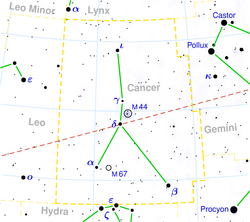Beta Cancri
| Observation data Epoch J2000 Equinox J2000 | |
|---|---|
| Constellation | Cancer |
| Right ascension | 08h 16m 30.9206s[1] |
| Declination | +09° 11′ 07.961″[1] |
| Apparent magnitude (V) | 3.536 [1] |
| Characteristics | |
| Spectral type | K4III [1] |
| U−B color index | -1.77 [1] |
| B−V color index | -1.48 [1] |
| Astrometry | |
| Radial velocity (Rv) | 22.94 [1] km/s |
| Proper motion (μ) | RA: -46.80 [1] mas/yr Dec.: −48.65 [1] mas/yr |
| Parallax (π) | 11.23 ± 0.97 mas[1] |
| Distance | 290 ± 30 ly (89 ± 8 pc) |
| Absolute magnitude (MV) | -1.21 |
| Details | |
| Radius | 48 ± 4 [2] R☉ |
| Luminosity | 660 [3] L☉ |
| Surface gravity (log g) | 1.51 [4] cgs |
| Temperature | 4,039 [4] K |
| Metallicity | -0.12 [4] |
| Rotational velocity (v sin i) | 8 [1] km/s |
| Other designations | |
| Database references | |
| SIMBAD | data |
Altarf (β Cnc, β Cancri, Tarf, Al Tarf) is the brightest star in the zodiacal constellation Cancer. At approximately 290 light years from earth, it has an apparent magnitude of +3.50 and absolute magnitude of -1.25 (visual).[1] The star is an orange K-type giant, about 48 times the radius of the Sun.[3]
The traditional name Tarf or Al Tarf (anglicized as Altarf), can be translated from Arabic as "end" or "edge".[3]
Altarf is known to have a fourteenth magnitude, red dwarf companion star. From its angular distance of 29 arcseconds, the companion's distance from its parent star is estimated at some 2600 AU, and has an orbital period of 76,000 years.[3]
In a paper published in the journal Astronomy & Astrophysics on May 12, 2014, evidence was presented of a planet orbiting Altarf. Using radial velocity data from repeated observations of the star, the planet is estimated to have a minimum mass of approximately 7.8 times that of Jupiter, and an orbit of 605 days.[5]
See also
- Lists of stars in the constellation Cancer
- Class K Stars
- Barium star
References
- ^ a b c d e f g h i j k l "SIMBAD query result: NSV 3973 -- Variable Star". Centre de Données astronomiques de Strasbourg. Retrieved 2010-02-23.
- ^
Nordgren, Tyler E.; et al., "Stellar Angular Diameters of Late-Type Giants and Supergiants Measured with the Navy Prototype Optical Interferometer", The Astronomical Journal, 118 (6): 3032–303, Bibcode:1999AJ....118.3032N, doi:10.1086/301114
{{citation}}: CS1 maint: multiple names: authors list (link) - ^ a b c d Kaler, James B. "AL TARF (Beta Cancri)". Stars. University of Illinois. Retrieved 2010-02-23.
- ^ a b c
Cenarro, A. J.; Peletier, R. F.; et al. (2007). "Medium-resolution Isaac Newton Telescope library of empirical spectra - II. The stellar atmospheric parameters". Monthly Notices of the Royal Astronomical Society (PDF). 374 (2): 664–690. arXiv:astro-ph/0611618. Bibcode:2007MNRAS.374..664C. doi:10.1111/j.1365-2966.2006.11196.x.
{{cite journal}}: CS1 maint: unflagged free DOI (link) - ^ Lee, B.-C.; Han, I.; Park, M.-G.; Mkrtichian, D. E.; Hatzes, A. P.; Kim, K.-M. (2014). "Planetary companions in K giants β Cancri, μ Leonis, and β Ursae Minoris". Astronomy & Astrophysics. 566. id.A67. arXiv:1405.2127. Bibcode:2014A&A...566A..67L. doi:10.1051/0004-6361/201322608.

